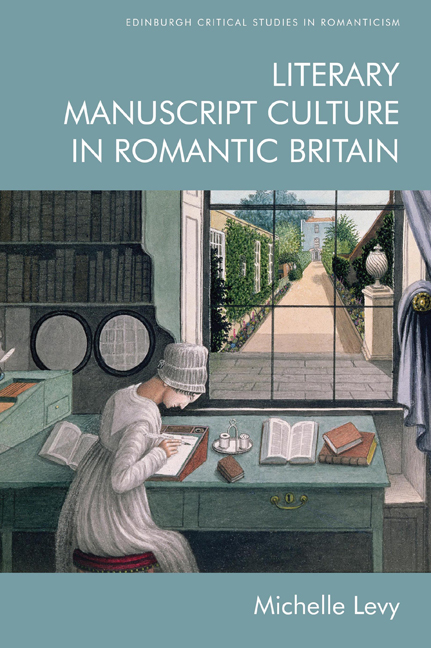Book contents
- Frontmatter
- Contents
- List of Illustrations
- Acknowledgements
- Dedication
- Introduction
- 1 Intentionality and the Romantic Literary Manuscript
- 2 Literary Reviews and the Reception of Manuscript Culture
- 3 Anna Barbauld’s Poetic Career in Script and Print
- 4 Lord Byron, Manuscript Poet
- 5 Jane Austen’s Fiction in Manuscript
- 6 Script’s Afterlives
- Afterword: Blake’s Digitised Printed Script
- References
- Index
- Plate Section
3 - Anna Barbauld’s Poetic Career in Script and Print
Published online by Cambridge University Press: 08 October 2020
- Frontmatter
- Contents
- List of Illustrations
- Acknowledgements
- Dedication
- Introduction
- 1 Intentionality and the Romantic Literary Manuscript
- 2 Literary Reviews and the Reception of Manuscript Culture
- 3 Anna Barbauld’s Poetic Career in Script and Print
- 4 Lord Byron, Manuscript Poet
- 5 Jane Austen’s Fiction in Manuscript
- 6 Script’s Afterlives
- Afterword: Blake’s Digitised Printed Script
- References
- Index
- Plate Section
Summary
Anna Barbauld's status as a canonical poet is now beginning to approximate the success she enjoyed in her own lifetime. In the most comprehensive collection of women's poetry for the period, Paula Backscheider and Catherine Ingrassia's British Women Poets of the Long Eighteenth Century (2009), more lines of verse by Barbauld are included than of any of the other eighty female poets represented. Barbauld's poems were highly regarded in her own day: one reviewer pronounced her Poems (1773) to be ‘inferior only to the works of Milton and Shakespeare’; and, after her death, she was declared to be ‘the first of English female authors; and we should find it difficult to name more than two or three modern authors of the other sex who can stand a comparison with her in both verse and prose’. Her commercial success was also nearly unprecedented, with Poems reaching five editions by 1777 and a corrected sixth edition in 1792, more published editions than any of her female predecessors, aside from Mary Chandler (1687–1745). Barbauld's poetic eminence was commemorated by a Wedgwood cameo in 1777 and by her inclusion in Richard Samuel's epic painting ‘The Nine Living Muses of Great Britain’, exhibited at the Royal Academy in 1779. Yet Barbauld's astonishing rise to poetic fame followed the print publication of a slim volume of fewer than three dozen poems, first published in 1773, at the urging of her brother, with a nearly identical final edition appearing in 1792, more than three decades before her death. Although she continued to write poems for the rest of her life, she could not be prevailed upon to print more than a handful of these, about sixteen, most of them in magazines and many of them without attribution. Overall, Barbauld elected to print just over a third, that is, fifty-three of her total output of 161 known poems. This chapter paraphrases Margaret Ezell: instead of asking, ‘Why didn't Barbauld use print’ for so many of her poems, it asks, ‘What is she attempting to do?’
Barbauld's career before the appearance of the 1773 Poems follows a conventional trajectory: her verse circulates in manuscript within widening circles, gaining appreciation, and then is collected and printed in a single-authored volume.
- Type
- Chapter
- Information
- Literary Manuscript Culture in Romantic Britain , pp. 101 - 139Publisher: Edinburgh University PressPrint publication year: 2020



